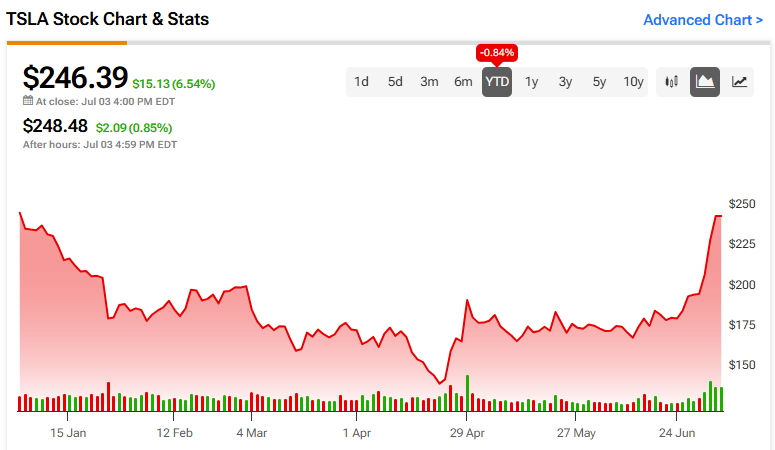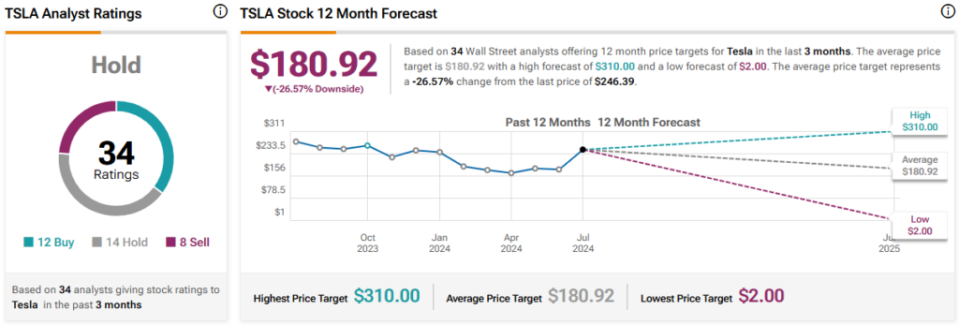Tesla (NASDAQ: TSLA) stock has rallied in recent weeks after beating second-quarter delivery expectations. The Elon Musk-led company has seen its stock rise 40.9% over the past 30 days and now trades at several hefty valuation multiples. I’m still neutral on Tesla, as I believe Robotaxi and robotics could be a game-changer for the business, but the valuation is hard to justify.

A Resurrected Tesla
In the second quarter, Tesla’s shipments fell 4.8% year-over-year (YoY), but that was better than the market expected. In the three months to June 30, Tesla delivered 443,956 vehicles, representing a 14.8% increase over the first quarter. The stock has risen since then, with positive numbers across the electric vehicle (EV) sector suggesting rising demand.
Tesla shares had already started rising in June after shareholders voted to give Musk his $56 billion pay package for 2018 and to reincorporate the company in Texas. The news sent Tesla shares jumping more than 10%, pushing it above $200 a share.
Is Tesla’s growth justified?
As a car manufacturer, Tesla is clearly overrated. Even Elon Musk has urged investors to value Tesla as a robotics or artificial intelligence (AI) company rather than a company focused solely on making road vehicles – even if they are electric. As such, some analysts may question why Tesla, which was already trading at elevated multiples, has grown on the back of these improved EV shipments. It’s a good point.
The stock currently trades at 96.4x forward non-GAAP earnings, making it EV’s most expensive stock by multiple and one of the most expensive tech companies. Furthermore, the expected earnings growth rate for the next three to five years is only 11.2%, suggesting that analysts see very little tangible impact from the Robotaxi business in the medium term.
In turn, this leads to a price-earnings-to-growth (PEG) ratio of 8.7x. This is well beyond what is typically considered attractive (1.0x or lower).
Other metrics make this rating unattractive. Shares trade at 8.3x TTM sales and 7.9x forward sales, representing an 830% and 813% premium to the sector, respectively. Tesla’s forward price-to-cash flow ratio of 63.9x also represents a 585% premium to the sector as a whole.
However, Musk has touted two big developments that will happen over the next 18 months. The first is the long-awaited Robotaxi – set to be unveiled on August 8 – and the second is the sale of its Optimus robots, which could start in the second half of 2025.
What could these developments mean for Tesla?
Autonomous driving offers Tesla the opportunity to dominate a new and exciting segment. From the outside looking in, Tesla seems to be ahead of the game when it comes to automation. We will learn more on August 8. Even Nvidia (NASDAQ: NVDA) CEO Jensen Huang agrees, noting recently that Tesla was “way ahead” in self-driving technology.
Robotaxi will allow Tesla to open up new revenue streams. Not surprisingly, one of these would be gyros. In 2023, 76% of Tesla’s revenue was generated from car sales, with another 8% generated from servicing. Only 5.8% or $6 billion was earned through its energy generation and storage division. Ride-hailing also promises wide margins.
Despite Robotaxis’ potential, I’ve seen very few analyst forecasts that actually seek to quantify that potential. Cathie Wood’s ARK is an exception. According to ARK Invest, nearly 90% of Tesla’s profits will be attributed to the Robotaxi business in 2029. In ARK’s unfavorable scenario, the autonomous transportation business will bring in $603 billion in 2029. In the scenario of bull, this figure increases to 951 billion dollars. In turn, this led Wood’s investment fund to suggest that the stock will be worth $2,600 in 2029.
It is worth admitting that the forecasts of ARK Invest have been rejected by many people as too ambitious. First, the global barrage market is expected to be $215.7 billion by 2028 (according to The extra). That’s less than half of what ARK believes Tesla would generate from hail transportation in its case for 2029. I can only assume that Wood’s fund is inferring that self-driving vehicles will bring about a displacement of big shift from car ownership to driving.
There are also questions about how Tesla could mass-produce a Robotaxis fleet large enough to generate the numbers predicted by ARK. Assuming a production cost of between $150,000 and $200,000 (per ARK Invest), building a global fleet of Robotaxis would likely cost trillions. Tesla does not have the necessary cash flow to build a global fleet.
Since the first quarter results, Musk has also touted Tesla’s potential in robotics, with “limited production” of its Optimus robot in 2025. According to Musk, the robots could turn Tesla into a $25 trillion company. However, investing in Tesla for its robotics capabilities may be too speculative, given how little we know.
Is Tesla stock a buy, according to analysts?
On TipRanks, TSLA comes in as a Hold based on 12 Buy, 14 Hold and eight Sell Ratings assigned by analysts in the past three months. The average price target on Tesla stock is $180.92, implying 26.57% downside potential.


The bottom line on Tesla stock
Despite Tesla being in pole position to dominate the autonomous era, I remain wary of Musk’s over-promising. That makes it very difficult to get behind a stock that is currently trading at 96.4x forward non-GAAP earnings. There can be a price for perfection, and if Musk under-delivers on August 8, the stock price could pull back significantly. That’s why I’m neutral.
DISCLOSURE